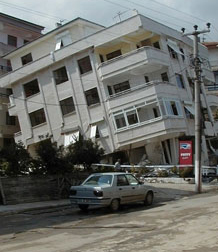Will stored CO2 leak?

The most important public concern about CCS is whether stored CO2 will leak back to the surface (land or sea) and into the atmosphere. This would be a hazard because CO2 at high concentrations is an asphyxiant, but it would also mean that the process would not be working as a climate change mitigation method.
However, for well-selected, designed and managed geological storage sites, the IPCC says that risks are low. CO2 could be trapped for millions of years, and well selected stores are likely to retain over 99 per cent of the injected CO2 over 1000 years.
Demonstration sites for CCS
It is important to study examples of CO2 storage. Norway 's Sleipner gas field is a demonstration site for CCS and is the oldest store of CO2 on an industrial scale. Environmental assessment of the gas field has concluded that storage is successful and that the Utsira Formation (the saline aquifer formation that stores the CO2) is stable and a suitable site for CO2 storage.
At another test site at Weyburn, Saskatchewan, Canada, the likelihood of stored CO2 release has been determined to be less than one per cent in 5000 years.
Studies of volcanic areas in Italy and Germany where carbon dioxide is naturally coming to the surface helps us learn more about how CO2 affects ecosystems. They show how ecosystems are coping with exposure to high CO2 concentrations and how effects are very localised.
Will earthquakes cause CO2 to leak?

CO2 storage sites will normally be positioned away from seismic (earthquake) activity and active faults. However in some tectonically-active parts of the world like Japan, New Zealand or Greece, CO2 may have to be stored closer to potential earthquake zones.
In October 2004, the Nagaoka CO2 storage and monitoring project in Japan experienced a large earthquake during a CO2 injection trial. The injection was stopped immediately and the site was monitored for possible CO2 leakage, however, no leakage was detected. In December 2004, injection was started again and a total of 10400 tonnes of CO2 has been safely stored.
If a site is well understood and characterised even a large earthquake in close proximity to a CO2 storage site should not result in leakage.
Seismic activity can also be caused by human activities. The most common form of ‘induced seismicity' is that caused by large surface water reservoirs, large buildings, and mining and extraction of minerals, groundwater, oil and natural gas.
In the case of extraction of groundwater, oil and natural gas, instability is caused by changes in the pressure in the affected geology, usually a de-pressurisation, which causes it to shrink or collapse slightly like a deflating ball. This process of de-pressurisation and pressurisation is well known and understood and can be managed in oil and gas fields, thus should not be a problem in CCS.







